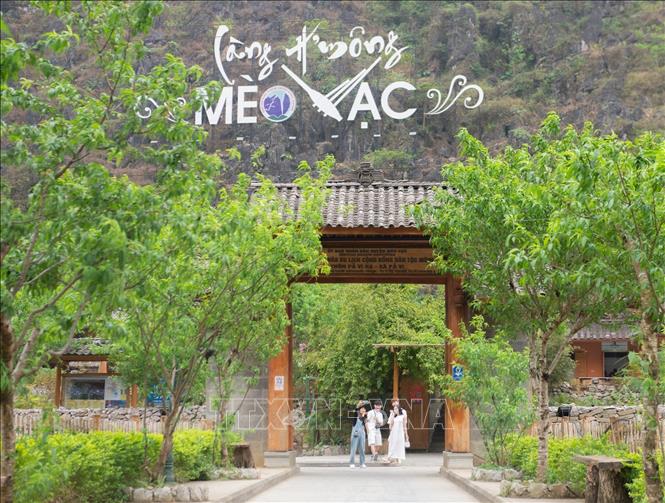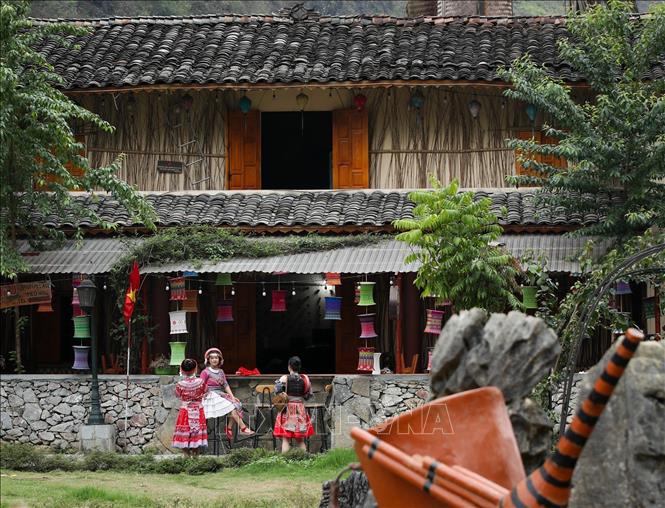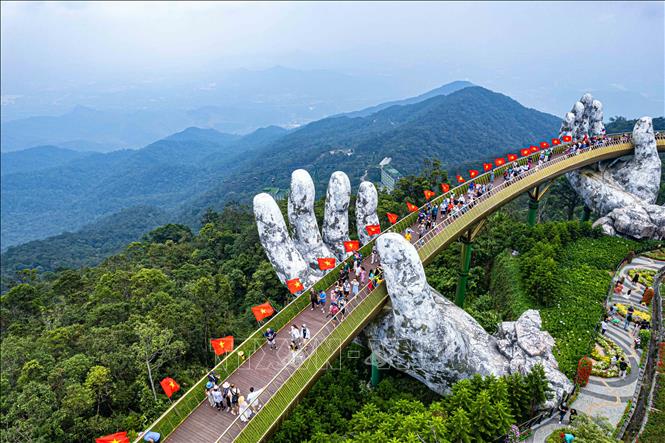Vietnam in general, and highland regions in particular, have a lot of potential for cultural tourism developme...
Vietnam in general, and highland regions in particular, have a lot of potential for cultural tourism development.
However, to leverage this advantage, the core principle is to preserve the authenticity, avoiding imitation, copying, and excessive commercialization, which can lead to a backlash and are not sustainable in the long run.
The form of tourism that embraces local culture as its essence

Tourists visiting and staying at the Community Cultural Tourism Village in Pa Vi Ha village (Pa Vi commune, Meo Vac district, Ha Giang province). Photo: Nam Thai/TTXVN.
Cultural tourism is a type of tourism in which travelers have the goal of understanding and experiencing the culture, history, customs, and traditions of a country or region. The bridge connecting tourists to their destinations includes cultural heritage, historical sites, traditional festivals, and community organization...
According to the Tourism Law of 2005, cultural tourism is a form of tourism based on the cultural identity of ethnic groups with the participation of the community to preserve and promote traditional values.
Currently, the type of tourism combining cultural exploration is becoming a new trend, bringing dual benefits: tourists gain interesting experiences while contributing to preserving and promoting cultural values.
Many localities and tourism businesses, especially in mountainous areas and areas inhabited by ethnic minorities, have relied on the unique cultural identity, customs, and traditions of the local community, combined with majestic natural landscapes, to create attractive tourism programs and products. Among these are Nghia Do tourism village (Lao Cai province), Lac village, Van village (Hoa Binh province), Sin Suoi Ho village (Lai Chau province), Luot village (Son La province), Xuan Son cultural tourism village (Phu Tho province), Lo Lo Chai cultural tourism village (Ha Giang province)...
In addition to well-known cultural tourism destinations, there are emerging destinations with promising prospects.

Tourists visit and stay at the Community Cultural Tourism Village in Pa Vi Ha village (Pa Vi commune, Meo Vac district, Ha Giang province). Photo: Nam Thai/TTXVN.
The western part of Nghe An province is mainly inhabited by ethnic groups such as Thai, Mong, Khơ Mú, Ơ Đu... The lives of ethnic minorities still face many difficulties, along with the risk of cultural erosion. Local authorities have begun to leverage the advantages of nature and the cultural identity of ethnic groups to develop tourism, attracting visitors to visit and stay in Mon Son commune (Con Cuong district), Muong Long commune (Ky Son district), Chau Tien commune (Quy Chau district).
Thanks to tourism, the Mong people in Mon Son commune have revived the traditional craft of weaving dresses and shirts to serve the demand for photo shoots, dance performances, and traditional flute melodies. Meanwhile, the Thai people in Chau Tien commune have utilized their traditional stilt houses passed down from their ancestors to offer homestay services. Additionally, they introduce visitors to the art of weaving brocade fabric and cooking ethnic dishes while organizing traditional dances and offering can wine...
Lam Binh district (Tuyen Quang province) is renowned for its Tay ethnic villages, where traditional stilt houses with palm leaf roofs are prevalent. Musical instruments such as Tinh lutes and clusters of xylophones, symbolic of the Tay people, are often hung on the walls of these houses. Lam Binh has reconstructed the fire dancing ritual of the Pa Then people into a unique tourism product, establishing numerous clubs for singing Then songs, playing Coi flutes, performing Pao dung songs, dancing Măng, playing Khèn flutes, folk songs, folk dances, brocade weaving villages, and embroidery.
Tua Chua is a poverty-stricken district in Dien Bien province with seven ethnic groups, of which the Mong people make up over 70%. The most attractive feature for tourists is the Mong ethnic markets in Ta Sin Thang and Xa Nhe communes, with a night market held every Saturday in Tua Chua town. This is where the cultural identity of the highland ethnic groups is most vividly expressed, providing tourists with profound and unforgettable experiences.
Counterfeit products harm cultural identity
Cultural tourists visiting a new destination seek to experience the local culture firsthand. Authenticity and uniqueness are prioritized over aesthetics and tastes in every aspect of cultural life: cuisine, clothing, customs, beliefs, religious activities, heritage, architecture, and handicrafts...
Preserving and developing tourism products imbued with cultural identity and beauty is the fundamental requirement that the tourism industry aims for to attract tourists.
 The Sun World Ba Na Hills tourist area decorated 100 red flags and golden stars along the Golden Bridge. Photo: Provided by TTXVN.
The Sun World Ba Na Hills tourist area decorated 100 red flags and golden stars along the Golden Bridge. Photo: Provided by TTXVN.
Contrary to this requirement is the trend of imitating ideas, copying landmarks, which is becoming quite common...
The Golden Bridge in the Ba Na Hills tourist area (Da Nang) has been carelessly "copied" in Soc Trang, Lam Dong. A "mini Venice (Italy)" has sprung up on Phu Quoc Island. The "Bali sky gate (Indonesia)" has been erected in Sa Pa (Lao Cai), Tam Dao (Vinh Phuc)...
These counterfeit products only meet short-term goals - catering to the virtual living needs of a portion of tourists, but in the long run, they are very harmful, eroding the unique characteristics of the region.
Mr. Nguyen Vu Khac Huy, General Director of Vina Phu Quoc Travel, Deputy Chairman of the Standing Committee of the Kien Giang Tourism Association, believes that borrowing and copying cultural features from abroad (or other regions) in tourist areas puts local culture at risk of being overshadowed. When tourists visit a certain place, they want to find the distinctive features of that place. Therefore, instead of clumsily imitating, creating flawed versions, each locality, each tourist destination needs to have its own unique, prominent structure, bearing cultural values, values specific to that destination.
Cultural identity is not simply about mimicking appearances but about the depth of history, the essence of a community filtered through hundreds, thousands of years.
The uniqueness of cultural identity is the key factor for tourists to return, alongside landscapes, service quality... Losing the cultural identity of the ethnic groups will make the tourist destination lose its attractiveness.
According to Dr. Tran Huu Son, Director of the Applied Folk Culture Research Institute, cultural tourism products with strict seasonal characteristics - cannot watch festivals, attend fairs on weekdays; cannot buy specialties when they are not in season...
It is imperative to resolutely combat counterfeit goods, "imitations" for cultural tourism products. Cultural performances, traditional ceremonies, cultural activities of any ethnic group must respect the objectivity, authenticity of the cultural essence of that ethnic group. Absolutely do not fake traditional cultural activities to attract tourists. To attract a large number of visitors, tourist destinations need to survey, compile schedules of festivals, Tet holidays, and community activities throughout the year to inform tourists, as well as promote and introduce to tourists so that they can visit in authentic settings.
The results of an international tourist survey in Vietnam show: 90% of tourists like to have local ethnic minorities as tour guides; 71% of tourists want to sleep and eat right in the villages of ethnic minorities; 81% of tourists want to participate in activities such as weaving fabric, cooking, making bath herbs... with local people; 83% of tourists want to buy souvenirs directly from the production places of local people in households.
Via Bao tin tuc